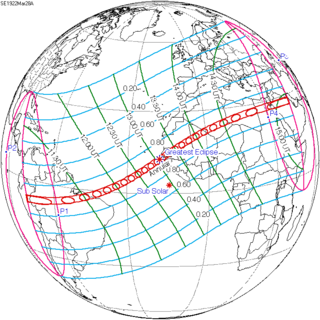| Solar eclipse of March 28, 1922 | |
|---|---|
| Type of eclipse | |
| Nature | Annular |
| Gamma | 0.1711 |
| Magnitude | 0.9381 |
| Maximum eclipse | |
| Duration | 470 s (7 min 50 s) |
| Coordinates | 12°18′N 18°00′W / 12.3°N 18°W |
| Max. width of band | 233 km (145 mi) |
| Times (UTC) | |
| Greatest eclipse | 13:05:26 |
| References | |
| Saros | 128 (53 of 73) |
| Catalog # (SE5000) | 9332 |
An annular solar eclipse occurred at the Moon's descending node of orbit on Tuesday, March 28, 1922,[1] with a magnitude of 0.9381. A solar eclipse occurs when the Moon passes between Earth and the Sun, thereby totally or partly obscuring the image of the Sun for a viewer on Earth. An annular solar eclipse occurs when the Moon's apparent diameter is smaller than the Sun's, blocking most of the Sun's light and causing the Sun to look like an annulus (ring). An annular eclipse appears as a partial eclipse over a region of the Earth thousands of kilometres wide. Occurring about 2.75 days after apogee (on March 25, 1922, at 19:30 UTC), the Moon's apparent diameter was smaller.[2]
Annularity was visible from Peru, Brazil, French West Africa (parts now belonging to Senegal, Mauritania and Mali), British Gambia (today's Gambia) including capital Banjul, French Algeria (today's Algeria), Italian Libya (today's Libya), Egypt, Kingdom of Hejaz and Sultanate of Nejd (now belonging to Saudi Arabia), and British Kuwait. A partial eclipse was visible for parts of South America, the Caribbean, North Africa, Central Africa, Europe, and the Middle East.
- ^ "March 28, 1922 Annular Solar Eclipse". timeanddate. Retrieved 2 August 2024.
- ^ "Moon Distances for London, United Kingdom, England". timeanddate. Retrieved 2 August 2024.
